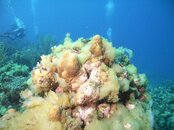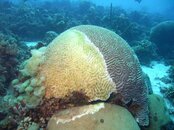UnderwaterBumbleBee
Contributor
I've been to several locations in the Caribbean and have seen this boogery looking stuff killing reefs. Someone told me it was a type of algae? These particular photos were taken in Curacao (though let me say that they have some of the healthiest reef conditions and fish populations I've seen). I saw a lot of this stuff in Roatan and some in Belize also. Anyone know what it is, what causes it?






